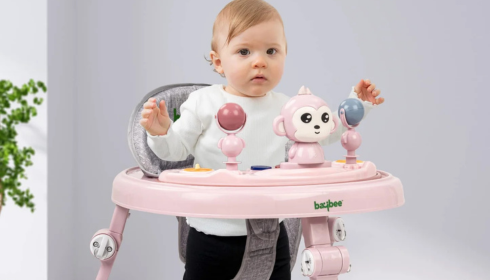When your little one begins to show signs of walking, it’s a thrilling time filled with excitement and new milestones. One of the most popular tools that parents consider during this phase is the baby walker. Designed to support a child’s first steps, baby walkers have evolved with modern safety features and engaging designs. But how do you pick the right one? In this guide, we’ll explore everything you need to know about baby walkers, from benefits and safety tips to top features and types available in the market.
What is a Baby Walker?
A baby walker is a device used by infants who are learning to walk. It usually consists of a hard plastic base with wheels, a seat made from fabric or plastic, and a play tray for entertainment. These walkers allow babies to move around independently while developing their motor skills.
Walkers come in different shapes and sizes, often incorporating bright colors, lights, music, and interactive toys to keep babies entertained while they explore their surroundings. The goal is not only mobility but also sensory and cognitive stimulation.
Benefits of Using a Baby Walker
Using a baby walker can offer several benefits:
- Encourages Movement: Walkers give babies the freedom to move around and explore their environment more actively, which can help strengthen their leg muscles.
- Promotes Independence: With a baby walker, your little one can move without constant support, giving them a sense of independence.
- Entertainment Value: Many walkers come with activity centers, including musical buttons, rattles, mirrors, and spinning toys, which help in sensory development.
- Parental Convenience: A walker can keep your baby safely engaged, allowing you to manage household chores without constantly carrying or watching over them.
Important Safety Considerations
While baby walkers are beneficial, safety must always be a priority. Here are a few key tips:
- Always supervise your child while they’re in the walker.
- Ensure the walker meets safety standards and certifications.
- Use the walker on a flat, hazard-free surface.
- Keep sharp objects, stairs, and hot appliances out of reach.
- Avoid using the walker near pools, bathrooms, or kitchens.
Look for models with features like wheel locks, seat belts, and anti-slip pads for extra security.
Types of Baby Walkers
There are mainly two types of baby walkers available:
- Seated Walkers: These are the traditional types where babies sit in a suspended seat. They usually come with wheels and an activity tray. These walkers support movement and offer fun activities.
- Push Walkers (Walk-Behind Walkers): These are ideal for older babies who are already pulling themselves up. Push walkers offer more balance control and are considered safer because babies can walk at their own pace.
Some hybrid models combine both types, giving you flexibility as your baby grows.
What to Look for When Buying a Baby Walker
To choose the best baby walker, consider the following:
- Age & Weight Limit: Always check the manufacturer’s recommendations.
- Build Quality: Ensure it’s sturdy, stable, and made from non-toxic materials.
- Comfort & Support: Look for cushioned seats and adjustable height settings.
- Portability: Foldable designs are perfect for small spaces and travel.
- Wheels: Swivel wheels offer better maneuverability; however, they should be smooth and durable.
Alternatives to Baby Walkers
Some pediatricians suggest limiting the use of baby walkers and instead recommend alternatives like:
- Stationary Activity Centers: These offer entertainment without movement, reducing the risk of injury.
- Tummy Time & Floor Play: Encourages natural motor skill development.
- Push Toys: Helps babies develop balance and coordination as they walk with support.
Conclusion
A baby walker can be a valuable tool in your child’s early development, offering both fun and mobility. However, choosing a model that prioritizes safety, comfort, and engagement is essential. As with any baby gear, supervision and appropriate use are key to making the experience both safe and enjoyable for your little one. Whether you opt for a seated walker or a push walker, always follow age guidelines and safety protocols to ensure your baby’s well-being.

